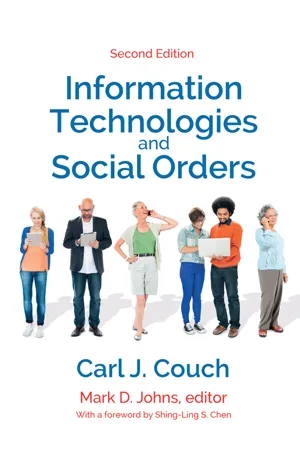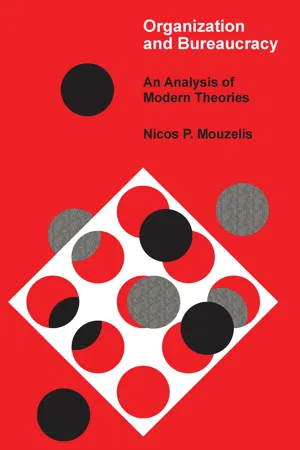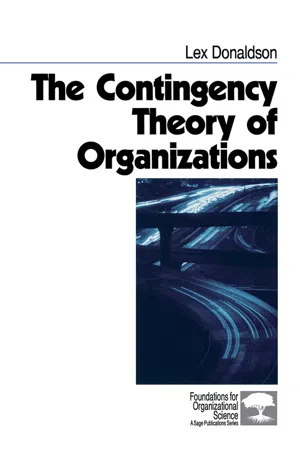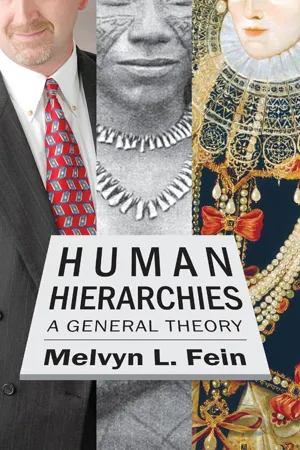Social Sciences
Bureaucracies
Bureaucracies are formal organizations characterized by hierarchical structures, standardized procedures, and specialized roles. They are designed to efficiently manage complex tasks and ensure consistency in decision-making. Bureaucracies are prevalent in government agencies, corporations, and other large institutions, and they play a crucial role in implementing policies, delivering services, and maintaining order in society.
Written by Perlego with AI-assistance
Related key terms
7 Key excerpts on "Bureaucracies"
- eBook - ePub
- Carl J. Couch, Mark D. Johns(Authors)
- 2017(Publication Date)
- Routledge(Publisher)
The bureaucratic paradigm implicitly denies that human action is willful and emergent. But social structures are created and maintained by people acting with intentionality and even the most rigid social structures constantly evolve and devolve. The establishment of a bureaucracy clearly is a willful act. As bureaucratic structures mature, the social objectives that informed their creation often recede and are supplanted by willful acts undertaken to promote personal advancement. However, the actions that maintain bureaucratic structures also are willful. All social action is given structure by persons projecting futures and organizing themselves to bring a projected future to fruition. The actions of no one, not even those of the most bureaucratized person, merely reflect norms and values.All bureaucrats recognize that not all action can proceed according to established formats. Yet the continuation of each bureaucratic structure is partially contingent on general acceptance of that belief. One irony is the belief among many social scientists that the paradigm of thought implied by bureaucratic structures is adequate for the analysis of social life. Only the most naive bureaucrats think that formal procedures are adequate for all situations; experienced bureaucrats know human action does not confine itself to bureaucratic formats. It would seem that specialists in the study of social structures would be as sophisticated about social structures as bureaucrats.Bureaucratic structures are one procedure for the management of large bodies of quantitative information. But bureaucratic structures are not the only procedure for processing information about communal welfare, and they certainly are not the ultimate social form. Instead of conceptualizing them as the epitome of rationality, as functionalists do, one might conceptualize them as an aberrant social form. A question that seems worthy of attention is: How can large bodies of information be managed without the creation of a set of social relationships that generates the sentiments and interests peculiar to Bureaucracies?ConclusionsBureaucratic structures have evolved from their first appearance five to six thousand years ago to being a significant dimension of nearly all complex organizations. Much of the evolution of Bureaucracies has been driven by a concern on the part of bureaucrats for greater efficiency, for example, the development of new surfaces on which to record information by the ancient Egyptians and the computerization of modern Bureaucracies. Papyrus allowed the Egyptian bureaucrats to be more efficient than their Sumerian counterparts, who recorded on clay. Computers make modern bureaucrats more efficient than those of the royal French state, who recorded information with quills on paper. - eBook - ePub
US Foreign Policy in Action
An Innovative Teaching Text
- Jeffrey S. Lantis(Author)
- 2012(Publication Date)
- Wiley-Blackwell(Publisher)
For the purposes of this study, foreign policy Bureaucracies are defined as executive branch organizations or agencies with a profound influence on US relations with the world. These organizations play a role in the day-to-day operations of any government; they represent the networks of professionals and institutions that make any large organization tick. Once you begin thinking about the presence of Bureaucracies, you can see evidence of them everywhere. The college or university you are attending is run by a bureaucracy (perhaps headed by a president, chancellor, or provost), and the state in which you reside is administered by a governor and scores of departments and offices.This approach adopts a bureaucratic politics frame – examining the policy process as an extension of the role of individuals, groups, and organizations in shaping policy. The federal government is, in many ways, a large and complicated network of Bureaucracies that manages domestic and foreign policy. It is important to remember several things about these organizations. While some associate the term bureaucracy with complicated processes, or “red tape,” these agencies are also the key to effective functioning of any large organization. Even though they are not elected, officials at different levels of Bureaucracies make policy decisions that impact the lives of citizens and non-citizens every day. Thus, focusing on Bureaucracies as key players in the process requires adopting a distinct theoretical approach. - eBook - ePub
Organization and Bureaucracy
An Analysis of Modern Theories
- T.A.J. Nicholson(Author)
- 2017(Publication Date)
- Routledge(Publisher)
42(d) If one dissociates from the concept of administrative rationality both the idea of efficiency and the existence of rules, one can give to this term a third relative meaning: if as Weber thought, it is evident that modern administrative behaviour has increasingly a rational orientation, looking at the organisation as a whole, one could conceive this trend as a shift from what Sumner calls a ‘crescive’ type of social organisation (with rules and goals spontaneously emerging in the course of human interaction) towards a type where men try (on the basis of scientific knowledge and rational thinking) deliberately to determine and shape the structure of such organisation according to their values and goals. Such rational orientations, although they often aim at an increase of organisational efficiency do not necessarily achieve this goal.43 This rational determination not to let things go by themselves (the effort toward conscious control of the organisational evolution) is not necessarily accompanied by the existence of strict procedural rules on the individual level, or by an increase in efficiency.C. Bureaucracy in terms of power
Finally, in order to complete the range of the various uses of the concept of bureaucracy, we should briefly mention a third group of definitions which have an abuse of power connotation (cf. chapter 1 , section 3). Such definitions are very common among political scientists and refer mainly to the state administration. Here as well the submeanings are numerous. For example, bureaucracy could imply an abuse in the domain of internal politics (overcentralisation, authoritarian controls, lack of democratic decision-making), or the abuse may refer to the organisation as a whole in its relation to other centres of power (‘big’ government, excessive power of the executive over the legislative, etc.),444. Final Considerations
- eBook - ePub
Bureaucracy and Politics in Mexico
The Case of the Secretariat of Programming and Budget
- Eduardo Torres Espinosa(Author)
- 2019(Publication Date)
- Routledge(Publisher)
The work of Max Weber represented a major starting-point of the sociological approach to bureaucracy. His theory underlines this institution’s ‘technical superiority over any other form of organization’ (Weber, 1946, p. 214). This superiority stems from its intrinsic attributes, namely, a hierarchical order, a clear division of labour, a set of rules governing operations, and a meritocratic system that protects bureaucrats from arbitrary dismissal (Heffron, 1989, p. 5). Though Weber’s prediction that bureaucracy would become a dominant form of organization proved right, his model must still be regarded as prescriptive. For it tells us how bureaucracy should be organized to attain high degrees of efficiency rather than how it operates in the real world.Weber’s so-called ideal type of bureaucracy provides a useful theoretical framework to find out how real Bureaucracies score when compared with it. It is a cliché to note that the European Bureaucracies are the best approximation to this model.1 The reason is that they are characterized by well-rooted civil services, high technical specialization maximized by a neat division of labour, and a relatively marked degree of political neutrality. Nevertheless, the media has never stopped reporting cases of inefficiency, red tape, waste, political bias and corruption. The realities beneath the news may explain the long tradition of the theory aimed at discovering methods for improving performance and effectiveness within organizations.Bureaucratic theorists have traditionally tried to find out who does decide in society, legitimately or not. Models of decision making are, therefore, abundant. According to the so-called rational choice models, for example, in any organization decision-makers behave as rational actors when selecting alternatives (see McGrew and Wilson, 1982, pp. 49-52). It means that each choice is decided after a comprehensive analysis of pros and cons. When public Bureaucracies are at stake, however, there are broader theoretical and practical issues that should not be neglected.There are two major problems for the models of ‘perfect administration’ which want to exclude politics (Minogue, 1983, p. 73). First, their assumption that internal organization does not involve politics is untenable, for organizations ‘contain groups of people, and individuals, who will compete with each other to control and manipulate resources, policies, practices’, and even the organization itself. Second, ‘the internal world of the organization cannot be isolated from the world external to the organization’. As a result, they leave out ‘too much of the rich lore of bureaucratic life that makes its study fun’ (Goodin, 1982, p. 23). - eBook - ePub
- Lex Donaldson(Author)
- 2001(Publication Date)
- SAGE Publications, Inc(Publisher)
Throughout much of this discussion size will be the main contingency, with task (i.e., task interdependence) a minor contingency. We will then discuss whether certain other causes of organizational structure are contingencies or not, in the process defining the criterion for a cause to be a contingency. Finally, we will attend to the issue of synthesizing the bureaucracy with the organic theory, in a way that follows on from, but goes farther than, the brief synthesis offered at the end of Chapter 1. Bureaucracy Theory Bureaucracy theory (Blau, 1970, 1972; Child 1973a) in its modern form emerged from a series of empirical studies. However, from the outset of modern research, thinking about bureaucracy was strongly influenced by the Weberian model of bureaucratic organizational structure, which omitted the idea of participation that is so central to organic theory. Weber (1968) held that there was a general, historical tendency for administration to move toward the bureaucratic type. The bureaucratic structure features full-time, salaried, career administrators who are appointed on merit, technically qualified, arranged in a hierarchy, and subject to rules and discipline (Weber 1964, pp. 333-334). Bureaucracy possessed several advantages including efficiency, predictability, reliability, and the “stringency of its discipline” (Weber 1964, p. 337). The development of bureaucratic structure is promoted by a number of factors, including size and communications technologies (Weber 1964, pp. 338-339). Bureaucratic theory led to a number of empirical studies that used qualitative methods to make case studies of organizations (Crozier 1964; Gouldner 1954; Selznick 1949) - eBook - ePub
From Max Weber
Essays in Sociology
- Max Weber(Author)
- 2013(Publication Date)
- Routledge(Publisher)
The advance of the bureaucratic structure rests upon ‘technical’ superiority. This fact leads here, as in the whole field of technique, to the following: the advance has been realized most slowly where older structural forms have been technically well developed and functionally adjusted to the requirements at hand. This was the case, for instance, in the administration of notables in England and hence England was the slowest of all countries to succumb to bureaucratization or, indeed, is still only partly in the process of doing so. The same general phenomenon exists when highly developed systems of gaslight or of steam railroads with large and fixed capital offer stronger obstacles to electrification than in completely new areas which are opened up for electrification.10 The Permanent Character of the Bureaucratic Machine
Once it is fully established, bureaucracy is among those social structures which are the hardest to destroy. Bureaucracy is the means of carrying ‘community action’ over into rationally ordered ‘societal action.’ Therefore, as an instrument for ‘societalizing’ relations of power, bureaucracy has been and is a power instrument of the first order—for the one who controls the bureaucratic apparatus.Under otherwise equal conditions, a ‘societal action,’ which is methodically ordered and led, is superior to every resistance of ‘mass’ or even of ‘communal action.’ And where the bureaucratization of administration has been completely carried through, a form of power relation is established that is practically unshatterable.The individual bureaucrat cannot squirm out of the apparatus in which he is harnessed. In contrast to the honorific or avocational ‘notable,’ the professional bureaucrat is chained to his activity by his entire material and ideal existence. In the great majority of cases, he is only a single cog in an ever-moving mechanism which prescribes to him an essentially fixed route of march. The official is entrusted with specialized tasks and normally the mechanism cannot be put into motion or arrested by him, but only from the very top. The individual bureaucrat is thus forged to the community of all the functionaries who are integrated into the mechanism. They have a common interest in seeing that the mechanism continues its functions and that the societally exercised authority carries on. - eBook - ePub
Human Hierarchies
A General Theory
- Melvyn L. Fein(Author)
- 2017(Publication Date)
- Routledge(Publisher)
First, let us enumerate some of the things that Bureaucracies get right. They are indeed efficient in exercising broad controls. In particular, their centralized restraints are good at producing speedy results. A functional division of labor, operationalized in defined offices, and arranged in a hierarchy of authority, allows directives emanating from the top of the pyramid to descend rapidly to the bottom. Because the participants know both who is in change, and who is responsible for what, legal orders move quickly down a succession of prearranged channels. This allows a CEO, within hours, to inform everyone, including the lowliest janitor, that they are expected to take flu shots the next day. Likewise, he can promptly inform his engineers and salespersons that a model line will shortly be revised. Yet not only speed, but precision flows from this arrangement. Orders move expeditiously, but also clearly. What the top bosses desire is transmitted, frequently in the form of memos, to underlings with the same clarity as when they began their journey. Thus, the time that employees are expected to show up at a sales rally is exactly specified. Unlike informal gossip chains, where messages are readily distorted, bureaucratic conduits are designed to ensure that orders are accurately understood. Pains are taken to make certain that everyone is playing by the same sheet of music.Another of the virtues of bureaucracy is that it allows for pooling vast quantities of knowledge. Precisely articulated networks of command can coordinate the activities of numerous experts. As a result, a supreme boss does not have to understand all of the particulars of automobile manufacture for his policies to tap into the understandings built into the psyches of battalions of workers. This enables the organization as a whole to be far more intelligent than any of its members. It allows the association, as a collectivity, to engage in enterprises no isolated individual could manage because no single person could ever know enough. Moreover, this vast database can continue to be employed irrespective of the participation of particular individuals. Bureaucracies have a continuity that outlasts specific human beings. Such enterprises can, therefore, span more than any given lifetime. Individual office holders come and go, but the Social Security Administration remains. Although individual office holders are not interchangeable, they are replaceable. When one succeeds another, their various operations may be modified, but there is sufficient permanence for the whole to keep functioning. This stability is, of course, furthered by the rules and procedures and the files and records, so central to the bureaucratic style. These, in their very impersonality, enable the enterprise to keep running even when its personalities change.Then too there is the advantage of reduced conflict. When imperative coordination is imposed by at least partially impersonal means, structural cushions soften clashes of interest. The parties are officially given to understand where each has dominance and, therefore, can better recognize when it is sensible to give way to another’s desires. Instead of contesting every potential area of dispute, they reserve their efforts for where they possess the best opportunities. Beyond this, when disputes do arise, a stabilized hierarchy can provide interventions by organizational arbiters. Official bosses impose decisions that short-circuit their subordinate’s quarrels. In the end, there is less squabbling about what should be done and more doing it. Put together, these benefits add up to lower costs. Because the bureaucracy is able to pursue its overarching goals more effectively, it generates greater quantities of what it aims to produce—with far less energy. When this occurs in a commercial firm, it translates into higher profits and greater longevity. When it occurs in governmental or nonprofit agencies, it better serves constituent’s needs.
Learn about this page
Index pages curate the most relevant extracts from our library of academic textbooks. They’ve been created using an in-house natural language model (NLM), each adding context and meaning to key research topics.






